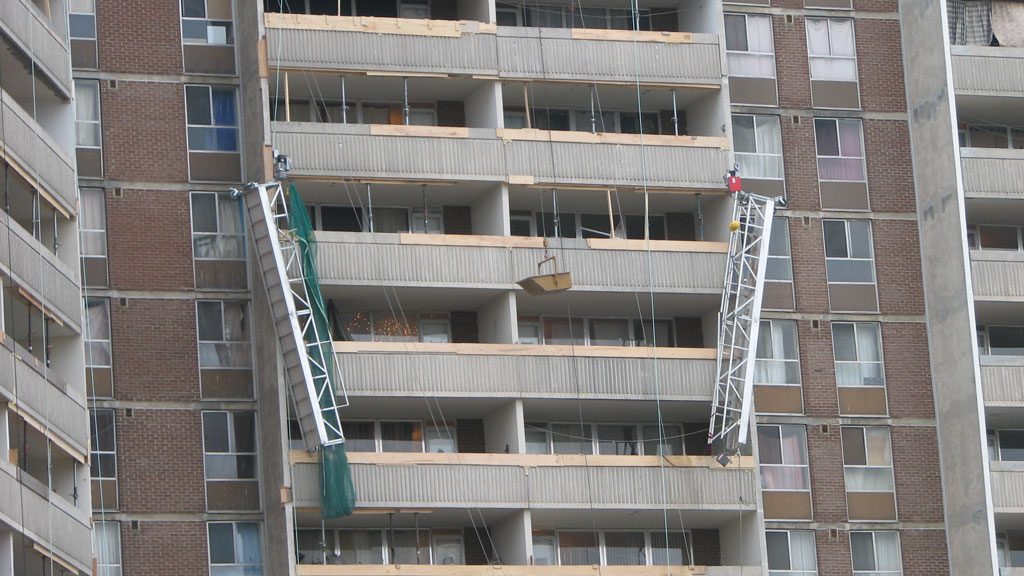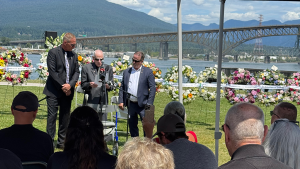December 24, 2009 is a day that many in the construction industry will never forget.
This year marks the 10th anniversary of the swing stage tragedy which killed four workers who were doing balcony repairs on a Toronto highrise when the swing stage they were working on collapsed.
Aleksey Blumberg, 33, Alexander Bondorev, 24, Vladimir Korostin, 40, and site supervisor Fayzullo Fazilov, 31, were killed in the incident. A fifth worker, Dilshod Marupov, was seriously injured after he hung on to the broken swing stage and then fell.
The project manager, Vadim Kazenelson, was holding onto a balcony when the swing stage gave way. He was charged with four counts of criminal negligence causing death and one count of causing bodily harm. He was also sentenced to serve three-and-a-half years in jail. He appealed the decision but the Court of Appeal upheld it. According to court documents, Kazenelson knew fall protection measures were not being used at the time of the incident.
Joel Swartz and his company Metron Construction were initially fined a total $342,000 in 2012, but a year later the fine went up to $750,000. Swing N Scaff Inc. of Ottawa, the swing stage supplier, was also fined $350,000 for failing to ensure the platform was in good condition.
The incident prompted the province to make changes to health and safety, which lead to the comprehensive review by Tony Dean, providing 40-plus recommendations.
The best thing we can do is move forward and make sure it doesn’t happen again,
— Enzo Garritano
Infrastructure Health and Safety Association
“For the most part, I would say that it was a game changer in terms of getting people to focus on health and safety in general,” Ontario’s Chief Prevention Officer (CPO) Ron Kelusky told The Daily Commercial News. “A decade later are we there? Have we accomplished everything we set out to? No, there is still a way to go.”
He added, “what is most important is we can’t just sit back and think the job is done — the job is never done. In health and safety, we have to be continuously vigilant as employers, as workers, and continue to work together to move the needle forward and to continue to reduce the number of injuries and fatalities within the province.”
While this year was better than last in terms of fatalities and injuries, there is always a need for improvement.
“We’re still the safest jurisdiction in Canada but that’s not something you celebrate when you still have fatalities and critical injuries occurring,” Kelusky pointed out.
“We have to constantly continue to improve. I think we’re now into a cycle where we are looking at things on a continual basis not simply sitting back and waiting for a tragedy to occur before we look at it.”
The tragedy led to Ontario’s government and associations collaborating on a number of health and safety initiatives and programs across the province in the industry over the past decade, said Enzo Garritano, president and CEO of the Infrastructure Health and Safety Association.
“These are things that change the province and we all understood that and we all tried to work towards making changes that were positive,” Garritano stated. “You can’t leave these things alone you have to take warning that this is a symptom of what’s going on in the industry unfortunately and make some improvements.”
“As for the system, I think we’re a lot stronger together now than perhaps we were in the past, moving forward in a more collaborative, aligned manner and we’re hoping that will yield better results overall,” he added. “The best thing we can do is move forward and make sure it doesn’t happen again.”
Some of the changes include developing a standard for working at heights, changes to the suspended access equipment regulations and the Certificate of Recognition program being increasingly required on projects in Ontario. More recently, Garritano noted, the Supporting Ontario’s Safe Employers program recognizes employers who successfully implement a health and safety management system in their workplace. Successful employers are accredited by the CPO.
“These are milestone activities that will change the landscape,” said Garritano. “We’re hopeful we can help shift the province forward in a health and safety-first mindset. Prior to 2009/10 era, buyers of services weren’t engaged to the level they are engaged today. Many of them now require COR as a pre-qualifier and there is evidence that COR in the other provinces has demonstrated significant change, real change, outcome-based change. These are things that back then weren’t around and now they are and they are pushing the envelope forward. We will continue to look for other opportunities because that’s what we have to do.”
A coroner’s inquest was called to investigate the deaths. It was supposed to be held in November but it has been rescheduled for early in the new year, Kelusky said.
“It’s hard to believe that the inquest is being held a decade after the event,” said Kelusky. “Generally speaking, what happens is they have to clean up all the legalities before you can get into the actual inquest itself. All that is out of the way now and they can focus on the inquest.”
— With files from Ian Harvey











Recent Comments